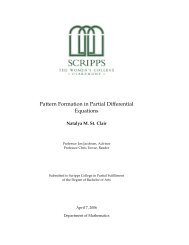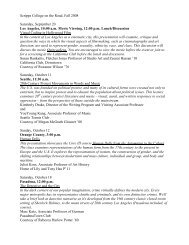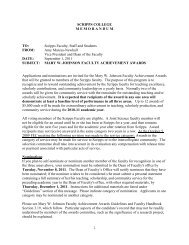Galois Theory: A Study of Cyclotomic Field ... - Scripps College
Galois Theory: A Study of Cyclotomic Field ... - Scripps College
Galois Theory: A Study of Cyclotomic Field ... - Scripps College
Create successful ePaper yourself
Turn your PDF publications into a flip-book with our unique Google optimized e-Paper software.
Pro<strong>of</strong> <strong>of</strong> the Main Theorem <strong>of</strong> <strong>Galois</strong> <strong>Theory</strong>. 13<br />
Since K/F is a <strong>Galois</strong> extension and F ⊂ L ⊂ K, the extension K/L is<br />
a <strong>Galois</strong> extension by Corollary 7. So, the degree <strong>of</strong> the extension [K : L] is<br />
equal to the order <strong>of</strong> H, denoted [K : L] = |H|. Using Lemma 14, we know<br />
that the order <strong>of</strong> H equals the degree <strong>of</strong> [K : K H ], or |H| = [K : K H ]. Since<br />
[K : L] = [K : K H ], and L ⊂ K H , we have L = K H .<br />
Now, suppose we start with H being a subgroup <strong>of</strong> G and we let L be<br />
the fixed field K H . Then H is a subgroup <strong>of</strong> G(K/L) since any element in<br />
H fixes L. That is, H ⊂ G(K/L). Now, the order <strong>of</strong> H is equal to the degree<br />
<strong>of</strong> the field extension from K H to K. But L = K H , so |H| = [K : K H ]. We<br />
know [K : L] is equal to |G(K/L)| since K/L is <strong>Galois</strong>. So we can conclude<br />
that [K : K H ] = [K : L] = |G(K/L)|. This gives us H = G(K/L).<br />
Now, we know that the two maps given by<br />
L ↦→ G(K/L) and H ↦→ K H<br />
are inverses. The Main Theorem <strong>of</strong> <strong>Galois</strong> <strong>Theory</strong>, as you may recall, stated<br />
that if K was a <strong>Galois</strong> extension <strong>of</strong> a field F , and G = G(K/F ) was its <strong>Galois</strong><br />
group, then there is a bijective map H ↦→ K H from the set <strong>of</strong> subgroups<br />
<strong>of</strong> G to the set <strong>of</strong> intermediate fields F ⊂ L ⊂ K. Further, its inverse function<br />
given by L ↦→ G(K/L). Further still, if H = G(K/L), then the degree<br />
<strong>of</strong> H is equal to [K : L], and [L : F ] = [G : H]. Since K/F was chosen to be<br />
a <strong>Galois</strong> extension <strong>of</strong> L, the degree <strong>of</strong> G is [K : F ]. Since |H| = [K : L] and<br />
[K : F ]/[K : L] = [L : K], with |G| being equal to [K : F ] and |H| equal<br />
to [K : L], we know [L : F ] = [G : H], and thus we have proved the Main<br />
Theorem <strong>of</strong> <strong>Galois</strong> <strong>Theory</strong>.<br />
□
















